The Model Of 1903 Springfield: A Collector’s Perspective
Collecting military surplus rifles is no longer a hobby you can blindly dive into, and certainly not when you’re on a budget. While the author, only being in his 30s, missed the golden age of inexpensive surplus firearms, he still fondly remembers $79 Mosin Nagants, $89 SKS rifles, and fully functioning U.S. service rifles from the Civilian Marksmanship Program (CMP) for under $500. Now that the prices of such entry-level collectibles have risen dramatically, it is becoming increasingly important for enthusiasts new to military-surplus collecting to educate themselves on their chosen subjects, which, in the end, saves money, time and staves off the potential for buyer’s remorse. With regards to seasoned collectors looking to branch out, it is also helpful to know all the facts behind a transaction in order to make a deal that is fair for both buyer and seller.
The U.S. Rifle, Caliber .30, Model of 1903
The market for U.S. service rifles varies wildly in price, between as low as $500 for arsenal rebuilds in rough shape to high-grade examples with desirable and proven provenance that go for thousands of dollars. One particular rifle that should have a place in every collector’s gun safe is the venerable U.S. Rifle, Caliber .30, Model of 1903, better known as the Model 1903 Springfield (M1903). Fielded just after the start of the 20th century, the M1903 saw hard service on the Western frontier, the Caribbean, the Philippines and the Mexican border before it was sent to World War I battlefields alongside the more numerous “U.S. Rifle, Caliber .30, Model of 1917” bolt-action. The M1903 then saw service during the inter-war period and soldiered on for the duration of World War II. An integral part to the story of the 20th century’s expansion of American power and influence, M1903s are a handsome and fine-shooting rifle to boot.
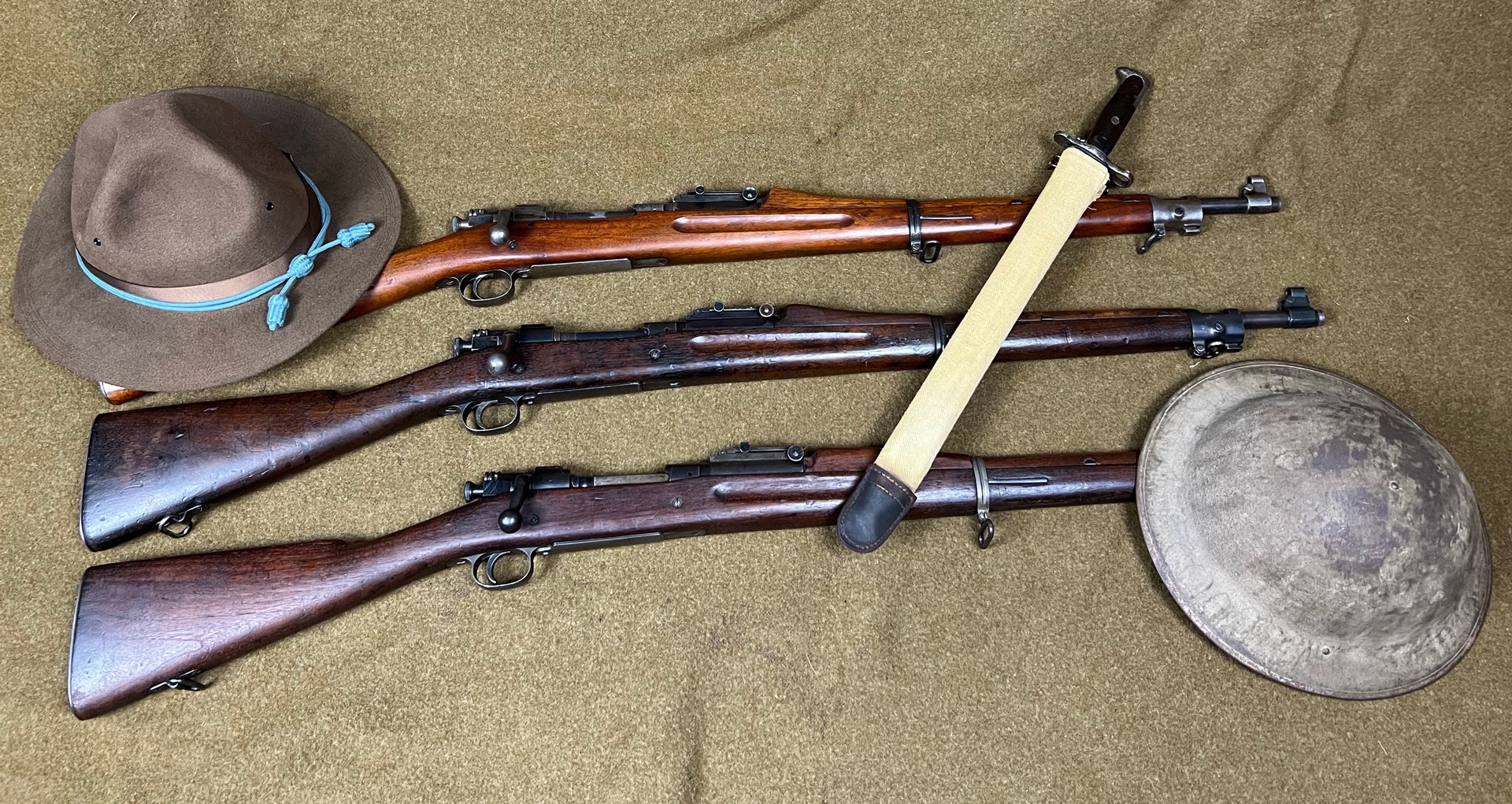 While many M1903s will look quite similar at first glance, once you start looking closely, you will often find the little ways they differ from one another.
While many M1903s will look quite similar at first glance, once you start looking closely, you will often find the little ways they differ from one another.
- Buy All-American!
- Bring health and vitality back to your body with these non-transdermal patches
- Get your Vitamin B17 & Get 10% Off With Promo Code TIM
- How To Protect Yourself From 5G, EMF & RF Radiation - Use promo code TIM to save $$$
- The Very Best All-American Made Supplements On The Maret
- Grab This Bucket Of Heirloom Seeds & Save with Promo Code TIM
- Here’s A Way You Can Stockpile Food For The Future
- Stockpile Your Ammo & Save $15 On Your First Order
- Preparing Also Means Detoxifying – Here’s One Simple Way To Detoxify
- The Very Best Chlorine Dioxide
- All-American, US Prime, High Choice Grass-Fed Beef with NO mRNA, hormones or antibiotics... ever!
What follows is a brief overview covering some of the things to look for when purchasing or evaluating an M1903 military-surplus rifle. This isn’t intended to be a deep dive on the subject, as whole books can, and have, been written that delve into fascinating minutia. The gold standard in that regard remains William S. Brophy’s The Springfield 1903 Rifles, although other exhaustive and scholarly works are out there as well and makes fantastic reading material for those wanting all of the subject details.
Manufacturers
At the outset of manufacturing, two government facilities were responsible for producing M1903 rifles: Springfield Armory in Massachusetts and Rock Island Arsenal in Illinois. Both plants began manufacturing rifles in 1903, with total production accounting for more than 1.5 million and 430,000 units, respectively. These numbers also include spare receivers. The earliest rifles produced were chambered for the heavy, blunt-nosed .30-’03 Sprg. cartridge and featured a rod-bayonet. Both of these were fairly short-lived, and rifles that retain these early traits are exceedingly rare, as they have somehow escaped the government’s overhaul process.
M1903 service-rifle production ceased at Springfield in 1936 and Rock Island in 1920. Following the adoption of the new M1 rifle in 1936, Springfield found itself busy producing those, while Rock Island busied itself with numerous other pieces of critical defense material. As war engulfed Europe, the United States called upon a commercial manufacturer to bring back the M1903: Remington. In addition to Remington, the typewriter company Smith-Corona also produced M1903A3 rifles from 1943-1944.
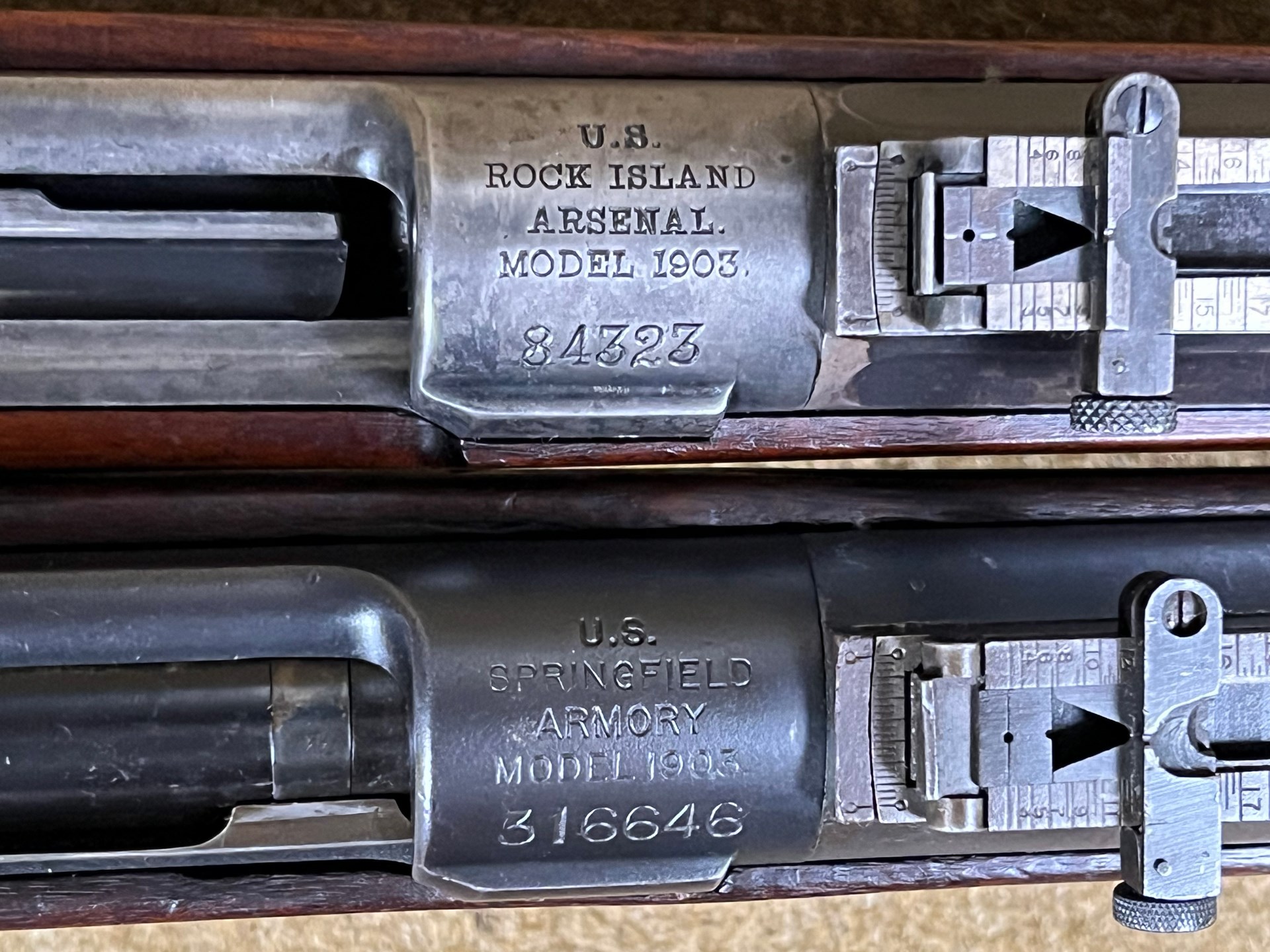 Two M1903 rifles, both produced in 1907, but at different government production facilities.
Two M1903 rifles, both produced in 1907, but at different government production facilities.
Remington produced M1903s between late 1941 and early 1943, at which time they fully transitioned to the production of “U.S. Rifle, Cal. .30, Model of 1903A3” and the “U.S. Rifle, Caliber .30, M1903A4, (Sniper’s).” At first, Remington produced the military’s request for standardized M1903s, which were very similar to those from Springfield and Rock Island, but it quickly transitioned to a modified standard that included a number of wartime expedients for increased manufacturing speed and reduced cost. Remington incorporated the use of stamped parts to replace some of the previously milled components and eliminated grasping grooves in the stocks.
So, if you are looking for a World War I-era rifle, your options are limited to Springfield- and Rock Island-produced rifles, with serial numbers below approximately 1,000,000 and 320,000 respectively. If, however, you are interested in having a rifle that saw service in World War II, all M1903s from Springfield, Rock Island and Remington would all fit the bill, along with M1903A3s from Remington and Smith-Corona.
The Dreaded Low Number Discussion
Any broad discussion of M1903s is incomplete without at least touching on the question of “low-number” rifles, specifically Springfield Arsenal M1903s under serial number 800,000 and Rock Island Arsenal M1903s under serial number 285,507. It is important to note that no Remington- or Smith-Corona-produced rifle is considered “low-number.” No topic in the U.S. firearm collecting community seems to inflame as many passions as this one, so I’ll attempt to walk a fine line here and only address the facts.
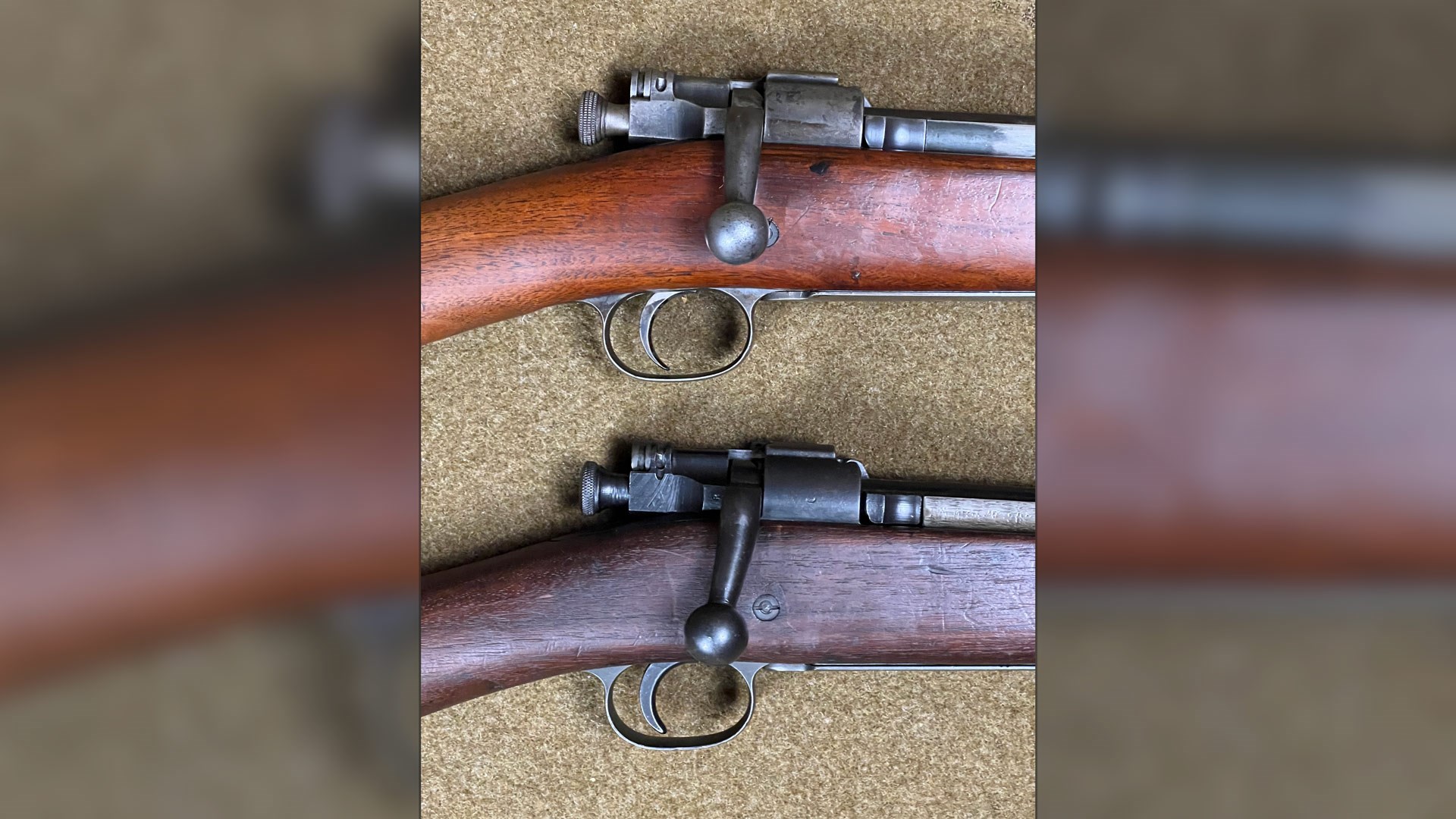 While the difference is subtle, the earlier bolt curves straight downward (top) while the later double-heat-treated bolt curves slightly rearward.
While the difference is subtle, the earlier bolt curves straight downward (top) while the later double-heat-treated bolt curves slightly rearward.
Rifles at, and above, those aforementioned serial numbers received a revised double-heat treatment at the arsenal that reduced the risk of producing a brittle receiver with the carbon steel then used. The problem of brittle steel came to light during World War I when reports of burst receivers filtered back to the Ordnance Department. While the catastrophic failures appear to be largely initiated from ammunition pressure, a decision was initially made to forego the rebuild of these rifles when they needed the overhaul.
Despite this, and inter-war instructions to limit their employment, many of these rifles soldiered on after hard use during the inter-war years and throughout World War II. In fact, Springfield Armory proposed issuing a public statement in American Rifleman in 1944 assuring the public that “The Ordnance Department believes that these early bolts and receivers unless worn to excessive headspace are entirely safe when shooting any standard or arsenal loaded ammunition.” Since this statement was pointed at the consumer market, the U.S. military seemingly believed in 1944 that these soon-to-be-obsolete rifles were safe in the hands of sport shooters and not merely to be used as a necessary exigency in a world war. More modern authorities come down differently, however, with the CMP having a prominent warning on its website stating, “CMP does not recommend firing any Springfield rifle with a ‘low number’ receiver. Such rifles should be regarded as collector’s items, not ‘shooters.’”
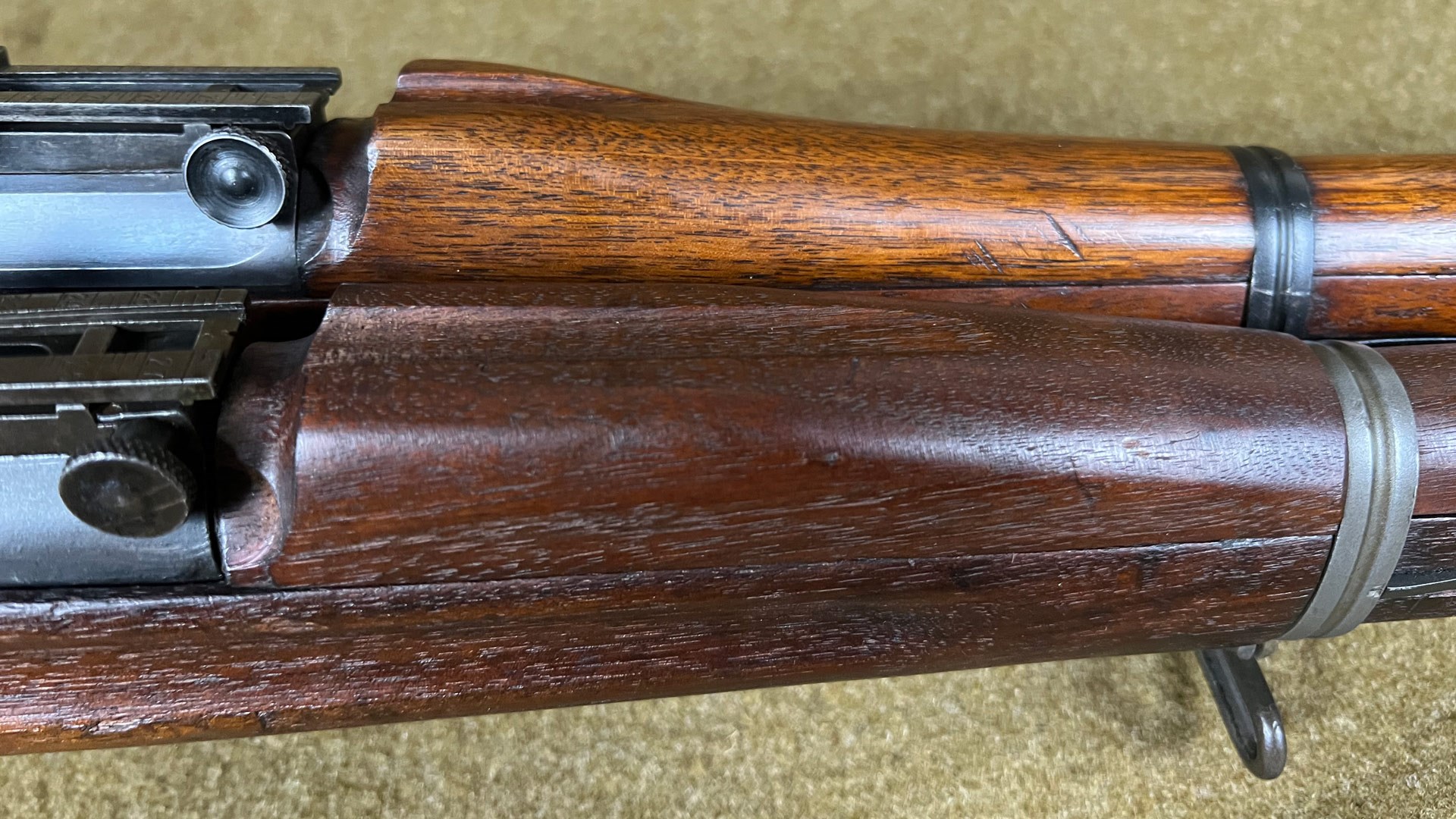 The earlier handguards have a more perceptible “hump,” and often a deeply cut sighting groove, while post-WWI handguards have a more gradual slope and longer sight channel.
The earlier handguards have a more perceptible “hump,” and often a deeply cut sighting groove, while post-WWI handguards have a more gradual slope and longer sight channel.
So, what does all that mean for the prospective buyer of military-surplus rifles of this era? Well, from a money standpoint, it means that low-number M1903s often command a decreased price from their high-numbered compatriots when found in comparable condition. For the collector not intending on shooting the rifle, or only shooting it with reenacting blanks, this might be a fantastic way to save some money or get a higher-condition example for the same price. Conversely, if a buyer intends to regularly shoot their venerable M1903, it may be a wiser option to obtain a high-number variant and remove any nagging doubt that a particular rifle may have a hidden heat-treatment defect. Perhaps the only non-controversial advice that can be given on the subject is that if you encounter a “sporterized” low-numbered rifle chambered for a caliber that produces pressures in excess of standard military .30-‘06 Sprg. loads, you really ought to steer clear.
All Numbers Matching—Lies, Damn Lies and Serial Numbers
For those that collect foreign military-surplus rifles, one of the first questions a prospective buyer might fairly ask is, “Do all the serial numbers match?” While not a totally ironclad method, for many arms, this will help the purchaser determine its “as-issued” condition from either the original factory or military overhaul facility. While this isn’t a definitive way to guarantee the firearm is all original—fakers sadly exist, and exceptions always apply—it provides a relatively reliable baseline for many of the popular and collectible foreign-military rifles on the market.
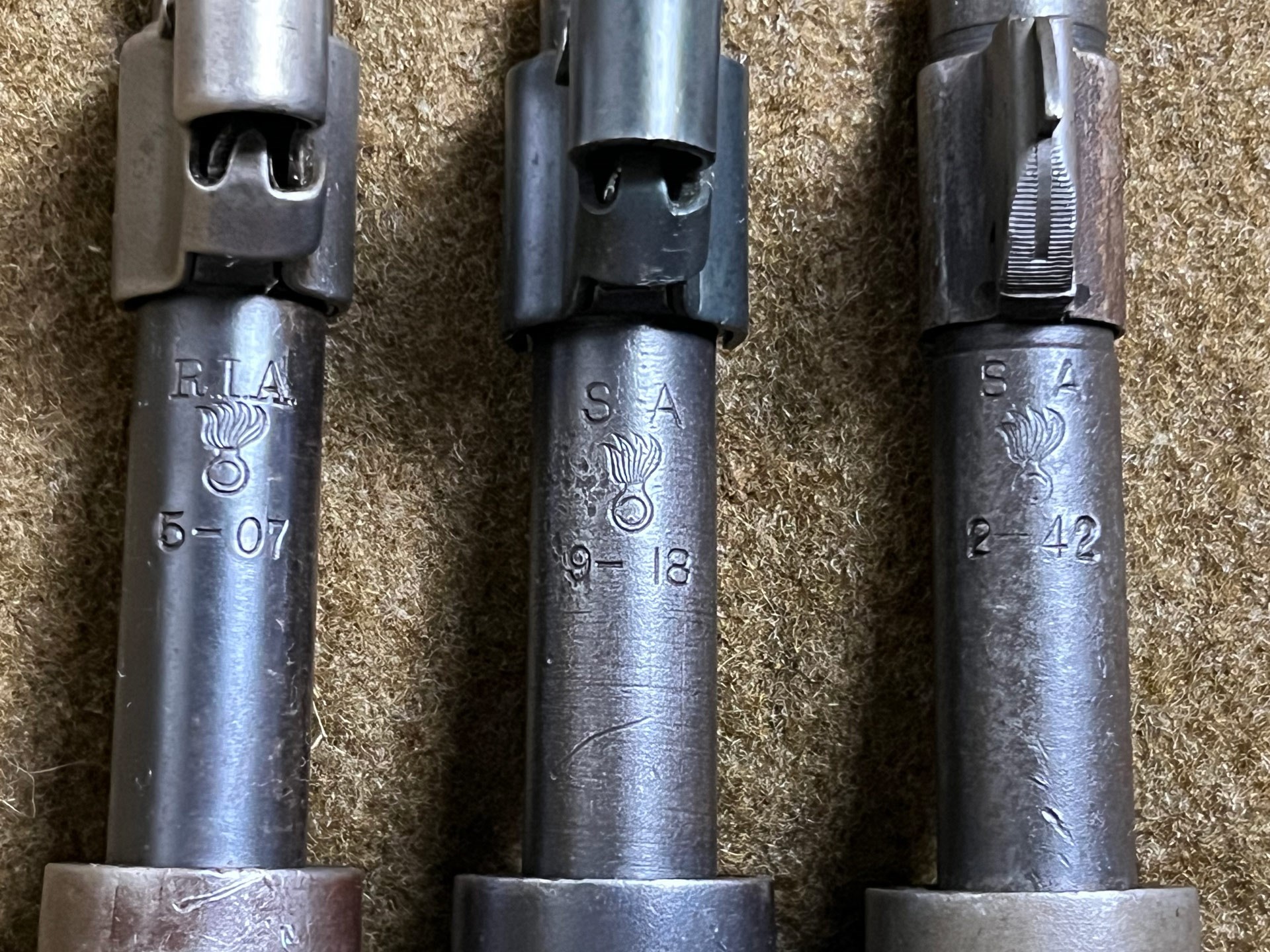 Military barrels feature the barrel manufacturer, Ordnance Department “flaming bomb,” and the month/year of barrel production. The left and center barrels are fitted to similar vintage rifles and are likely original, while the right barrel is a less-finely finished early World War II replacement part.
Military barrels feature the barrel manufacturer, Ordnance Department “flaming bomb,” and the month/year of barrel production. The left and center barrels are fitted to similar vintage rifles and are likely original, while the right barrel is a less-finely finished early World War II replacement part.
If, however, you hear a seller describe an M1903 as “all-matching,” you should immediately be on guard. In this area, the modern-day collector is impacted by the U.S. military’s decision to NOT utilize serial-number stampings on most major parts, like the Soviets have, or nearly each and every small part as seen on German guns. Instead, the standard U.S. practice was to serialize only the receiver, while all other parts bear either no markings or some combination of manufacturer marks, inspector marks, proofmarks or drawing numbers. There are exceptions of course, which includes National Match and some U.S. Marine Corps M1903s, with serial numbers applied to their bolts by an electro-pencil, but the vast majority of M1903s will feature only a single serial number.
This makes determining if a rifle is a “right one” a much more daunting prospect for the new collector when compared to just matching up serial numbers that are plastered all over a gun. Also, given the relatively long service life of the M1903, most have been through one or more arsenal overhauls. There is certainly no shame in having one of these “mix-master” rifles.
Understanding M1903 Barrels
Below is a breakdown describing some of the different major components that can be found on M1903s. It is designed to provide a general idea and understanding of the rifle and its associated factory or refurbished parts in a general path through history and the U.S. arsenal system, thereby allowing potential collectors to better gauge the value of collectible examples.
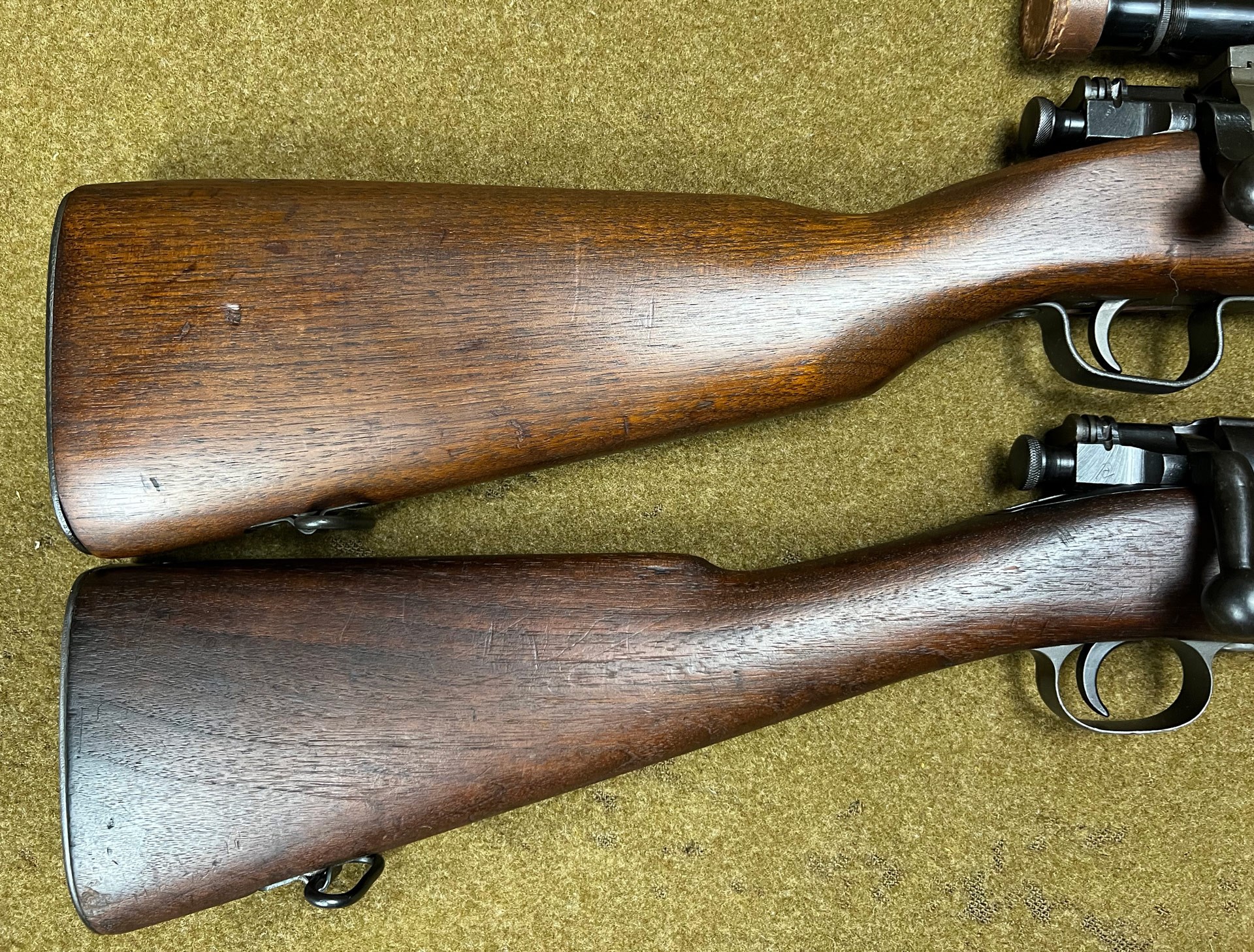 The scant stock was a clever way to gain some of the benefits of a pistol gripped stock while making use of the large stores of stock blanks originally destined for straight stocks. Stock preparation was a time-consuming and expensive venture, and Uncle Sam wanted to ensure it didn’t go to waste.
The scant stock was a clever way to gain some of the benefits of a pistol gripped stock while making use of the large stores of stock blanks originally destined for straight stocks. Stock preparation was a time-consuming and expensive venture, and Uncle Sam wanted to ensure it didn’t go to waste.
Besides the information prominently stamped on the receiver, the next most notable marking on most M1903s is the barrel information. It is located immediately behind the front sight on the top of the barrel and typically has the following information stacked vertically: manufacturer, “flaming bomb” ordnance mark and the month and year the barrel was made. It is important to note that the barrel date, even on a rifle with an original barrel, does not necessarily indicate the date the receiver was made or the rifle assembled, although they do tend to be close. Instead, the estimated “birthday” of your rifle can be determined by a number of searchable internet sources or hard-copy publications that draw from arsenal production records. If that date, the barrel information and the finish wear are reasonably close, it is likely that the barrel is original to the rifle.
Much more likely, especially with World War I and earlier M1903s, are replacement barrels. These became necessary for all the standard reasons: normal service wear, poor maintenance habits such as mangling the throat or muzzle and service-connected damage. Additionally, since the U.S. Army used corrosive ammunition through World War II, bore damage is possible, especially through negligent care and maintenance.
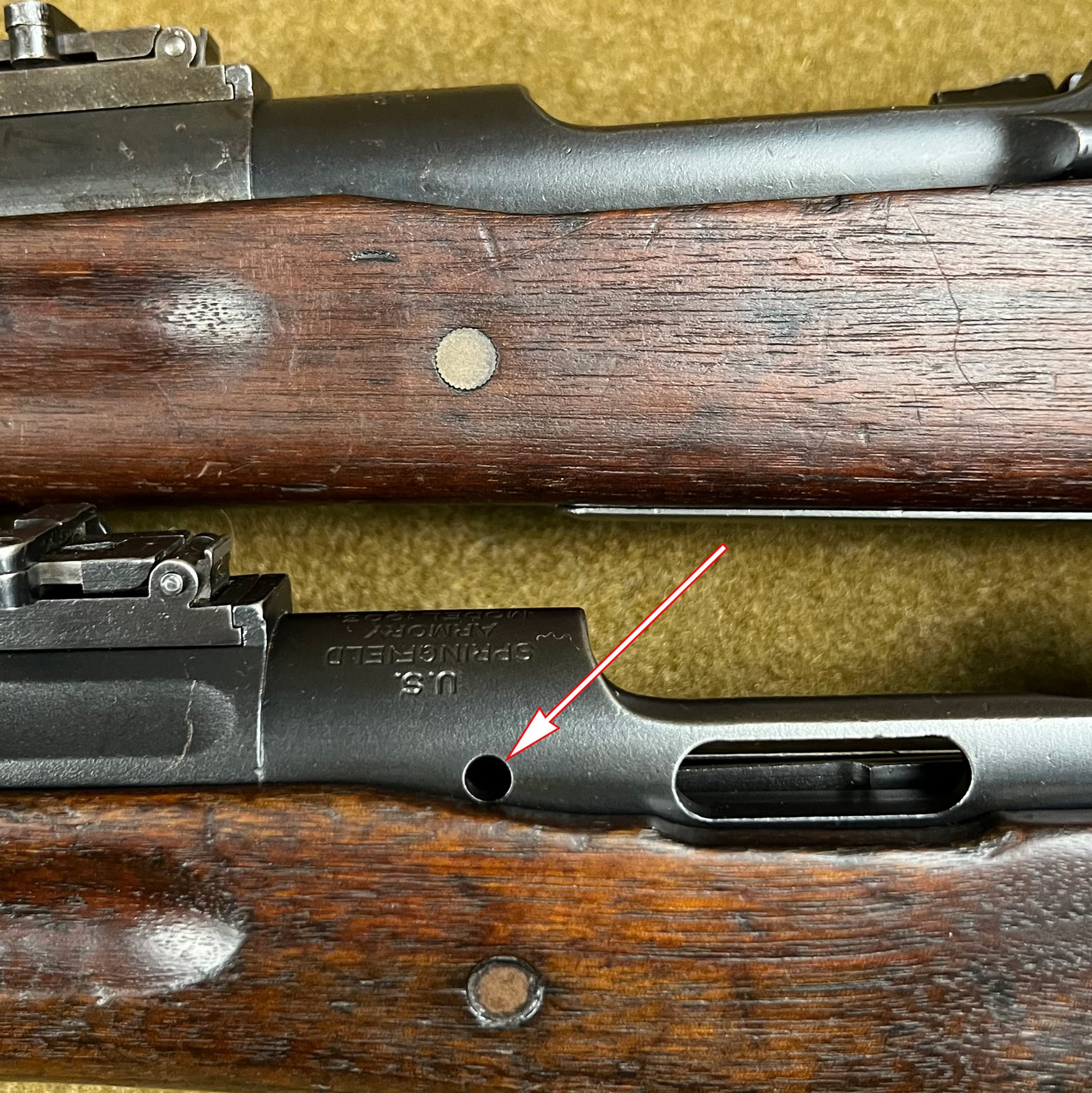 The top rifle never received an auxiliary gas escape hole (arrow), while the bottom M1903 Mark I was upgraded with one later in its service life.
The top rifle never received an auxiliary gas escape hole (arrow), while the bottom M1903 Mark I was upgraded with one later in its service life.
The barrels themselves run the gamut of quality, from star-gauged barrels produced for target or competition use, to the standard yet, finely finished pre-World War I and inter-war examples, to World War II-era arsenal rebuilds that exhibit details that explain the haste with which they were made, through their rough cosmetics and crudely finished crowns. Besides the star-gauged barrels, which are sought after because of their specially gauged tolerances and potential for increased accuracy, most barrels give good service, regardless of their external beauty. In addition to the arsenal-manufactured replacement barrels, commercial firms Avis, High Standard, Johnson Automatics and Sedgley were called upon to make barrels for M1903 rifles.
In fact, replacement barrels can serve as an interesting insight into the life of a service rifle. For instance, one specific rifle I’ve sen with a barrel dated 2-42 indicates the barrel was made in February 1942. That same rifle also features a stamping on the stock indicating it was overhauled at Benecia Arsenal in California. Taken together, it is possible, although not specifically provable, that at some point during the 1942-1943 rush to arm the no-longer-sleeping-giant that was the United States, the rifle was refurbished and supplied to either troops destined for the Pacific Theater or handed over to industrial or defense guards on the West Coast. Interestingly, that same rifle is also linked to service along the Mexican border in 1916, which is just one example of a varied service life these military-surplus rifles may have had.
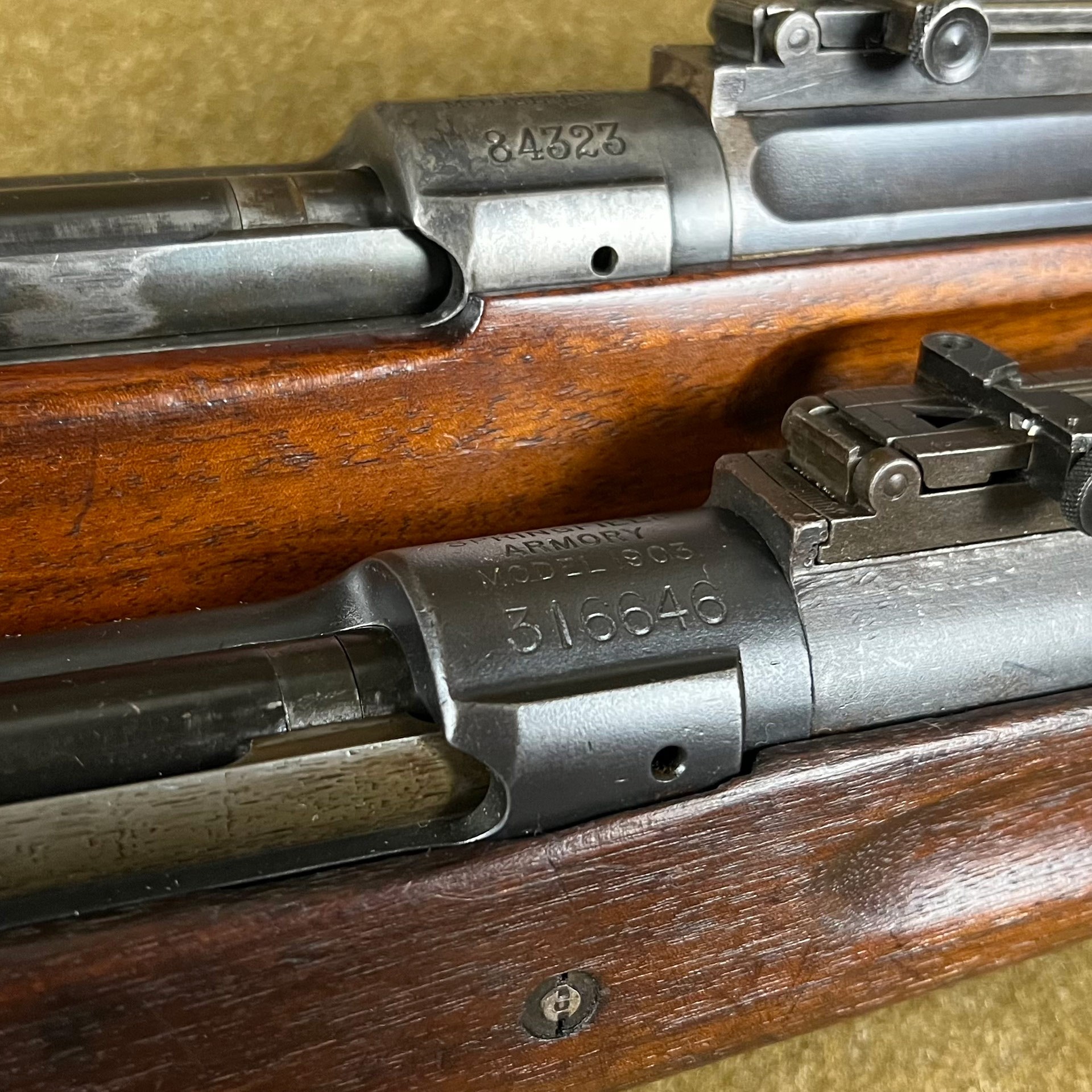 Early production stocks like the one featured a slightly higher wood profile, as well as sharp corners. These proved prone to damage, and “low-wood” stocks were adopted fairly early on in the service life of the M1903.
Early production stocks like the one featured a slightly higher wood profile, as well as sharp corners. These proved prone to damage, and “low-wood” stocks were adopted fairly early on in the service life of the M1903.
As a buyer, you need to ask what matters to you most. If you are primarily concerned with the shooting performance, your task is more mechanical than sentimental, and normal gun-inspection rules control. This means you must certify the bore is in good condition, which primarily entails a visual inspection to ensure prominent rifling and a general lack of pitting. While a bright and shiny bore is usually a good sign, a darker bore can even give good results, so long as the rifling is not eroded from heavy use or improper or negligent cleaning. For that reason, if possible, it is always best to test-fire a prospective purchase. In some instances, the previous owner may also provide an inside scoop on the gun’s accuracy potential or possible reasons for concern. It can be overly easy to become swayed one direction or another with a false story or inconclusive details seen during a simple visual inspection.
In collecting U.S. military-surplus rifles in particular, much attention should be given to muzzle erosion (ME) and throat erosion (TE), which is where the rifling ends and begins, respectively. Although it is far from conclusive, measuring the erosion will provide a mechanical insight into the barrel’s accuracy potential. Both of these numbers, ME and TE, were used by military armorers to determine whether a barrel was still serviceable for field use, and numbered gauges are available to rate this wear quotient.
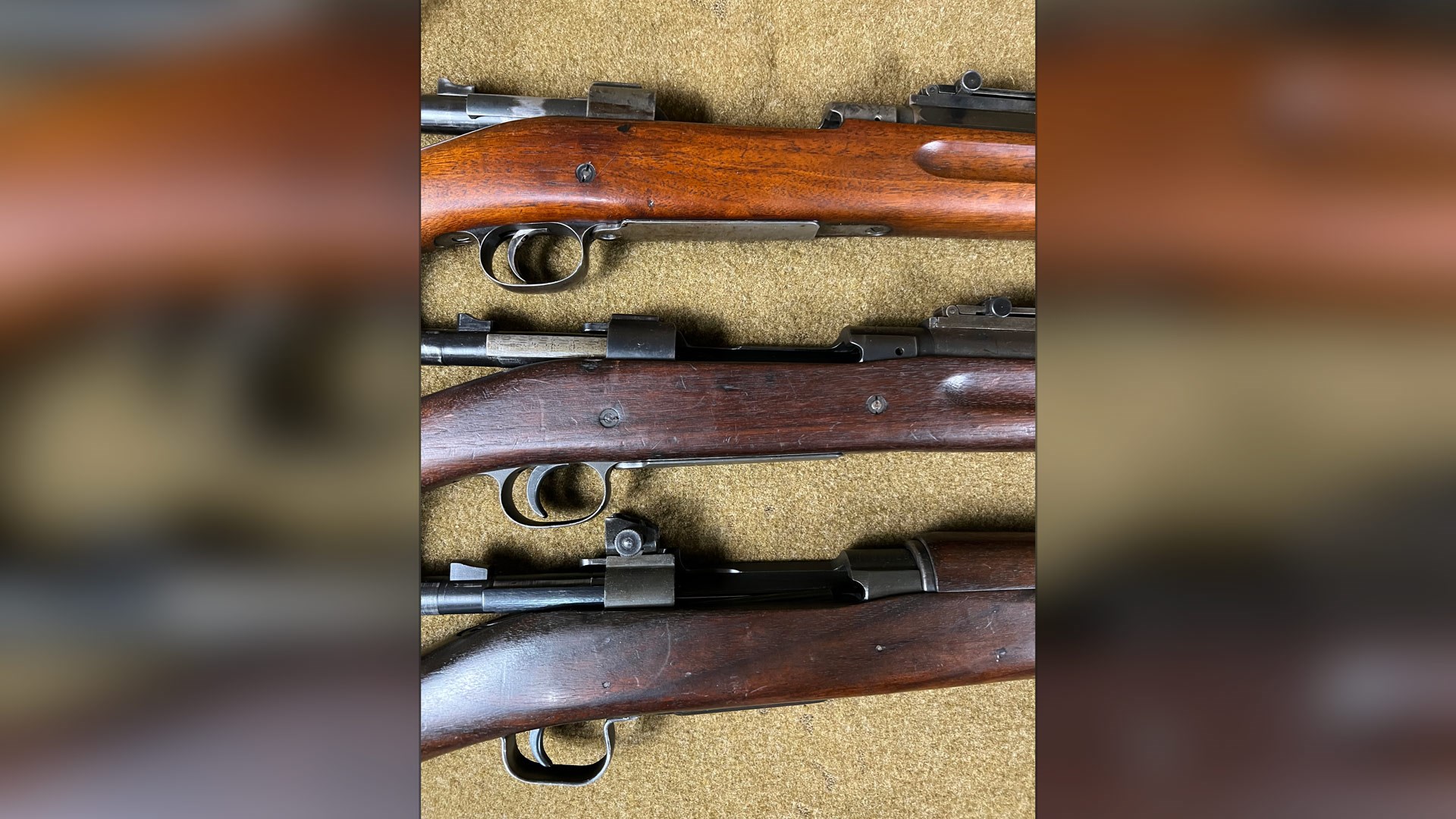 The earliest M1903s featured no stock reinforcing bolts/screws. This was later changed to one, and eventually two, reinforcing points by World War I. During World War II production, some rifles were briefly produced with pins instead, but they did not prove suitably strong.
The earliest M1903s featured no stock reinforcing bolts/screws. This was later changed to one, and eventually two, reinforcing points by World War I. During World War II production, some rifles were briefly produced with pins instead, but they did not prove suitably strong.
Between the two numbers, ME is much more likely to have an impact on accuracy, as the rifling at the end of the barrel is the last thing within the shooter’s control acting on the projectile before it is sent hurtling downrange. While precision shooters carefully tune a cartridge’s overall length to maximize accuracy by minimizing, or totally eliminating, bullet-jump from its seated position through the throat and into the rifling, all but the most worn-out service rifle throats should function sufficiently well and not greatly impede accuracy. For those interested in focusing on U.S. military arms, an ME gauge is a good investment, and while a TE gauge probably isn’t a necessity, it can’t hurt for those who are interested in checking every facet of their firearms.
If you are instead a collector who just wants a barrel that is correct for the rifle, and bore condition is of lesser concern, the first question you must ask is correct for what? If the desire for a rifle is in as-manufactured condition, a barrel that is within a relatively small window from the time the receiver itself was made will fit the bill. If an as-is, working example from World War I is sought, a barrel date that predates August 1918 or so must be sourced to ensure the barrel was manufactured, installed and issued before hostilities ceased on Nov. 11, 1918. M1903s used during World War II tend to be the easiest to find, as it can wear a barrel of any vintage between 1906 and the mid-1940s, and still be of proper form, depending on other associated parts.
Most prospective owners strike a balance between the two approaches and seemingly do their best to blend the two methods of finding a barrel, and a rifle, that appeals to both the practical shooting aspect as well as the rich ties to historical events that these rifles have.
Understanding M1903 Bolts
Tied to the low-number concerns, M1903s have both single- and double-heat-treated bolts. Fortunately, they are readily identifiable, as single-treated bolts are “straight,” in that, when viewed from the side, they curve straight down, while the later double-treated bolts are “swept back” slightly. In addition to providing a quick indicator as to the heat treatment of the bolt, it also serves as a handy dividing line for the age-appropriateness of the bolt to the rifle. The changeover in styles shortly followed the change in receiver heat-treatment, so a straight-curved bolt will be generally correct for a World War I or earlier M1903, while the swept-back style is found on late-1918 and onward production runs. Like the low-numbered receivers, the CMP cautiously advised not “firing any Springfield rifle, regardless of serial number, with a single heat-treated ‘low number’ bolt. Such bolts, while historically correct for display with a rifle of World War I or earlier vintage, may be dangerous to use for shooting.”
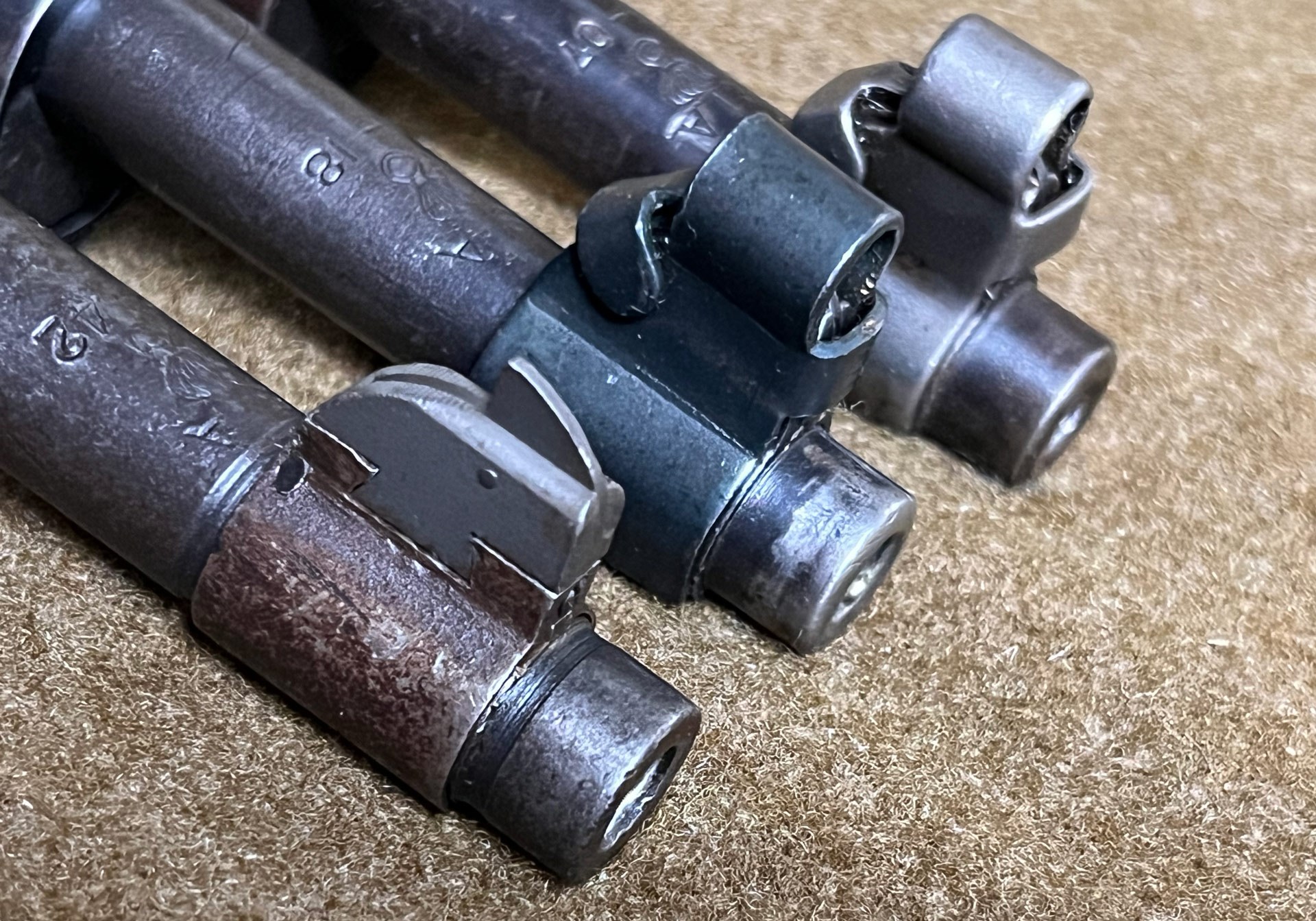 Another photo of the barrels highlights the crude finish exhibited by the World War II-era replacement (front).
Another photo of the barrels highlights the crude finish exhibited by the World War II-era replacement (front).
For the serious collector, Springfield and Rock Island M1903 bolts feature a steel lot code stamped on the bolt body, typically on either the bottom of the safety lug or on the root of the bolt handle. While not as simple as a stamped serial number, these codes can be used to narrow down bolts by manufacturer and date range in order to help determine if a particular bolt is a correct “as-issued” bolt or was a replacement somewhere later down the line. Bolt bodies for the M1903A3 can be found in new-old-stock (NOS) condition, feature swept-back bolt handles and will show increased marks from the manufacturing process, as well as a slightly different profile in the body. While M1903 and M1903A3 bolt bodies generally interchange with one another, a headspace check using the gauges is always advisable to anyone wanting to swap or replace bolts.
Understanding M1903 Stocks
Stocks for standard military M1903 rifles can be broken into three broad groups: Straight stocks (with or without grasping grooves), pistol-gripped “C” stocks and “scant” stocks. All original stocks are made out of American black walnut with an oil finish. When fitted at the factory, stocks will have an inspector’s cartouche on the left side below the receiver and a firing proof “P” on the underside of the wrist. While both marks started off with fancy script lettering, as manufacturing progressed, both changed into simple block lettering. Additionally, when rifles were sent through the re-build process, they were often stamped on the left of the stock with a two-to-four letter code that indicated what arsenal completed the work.
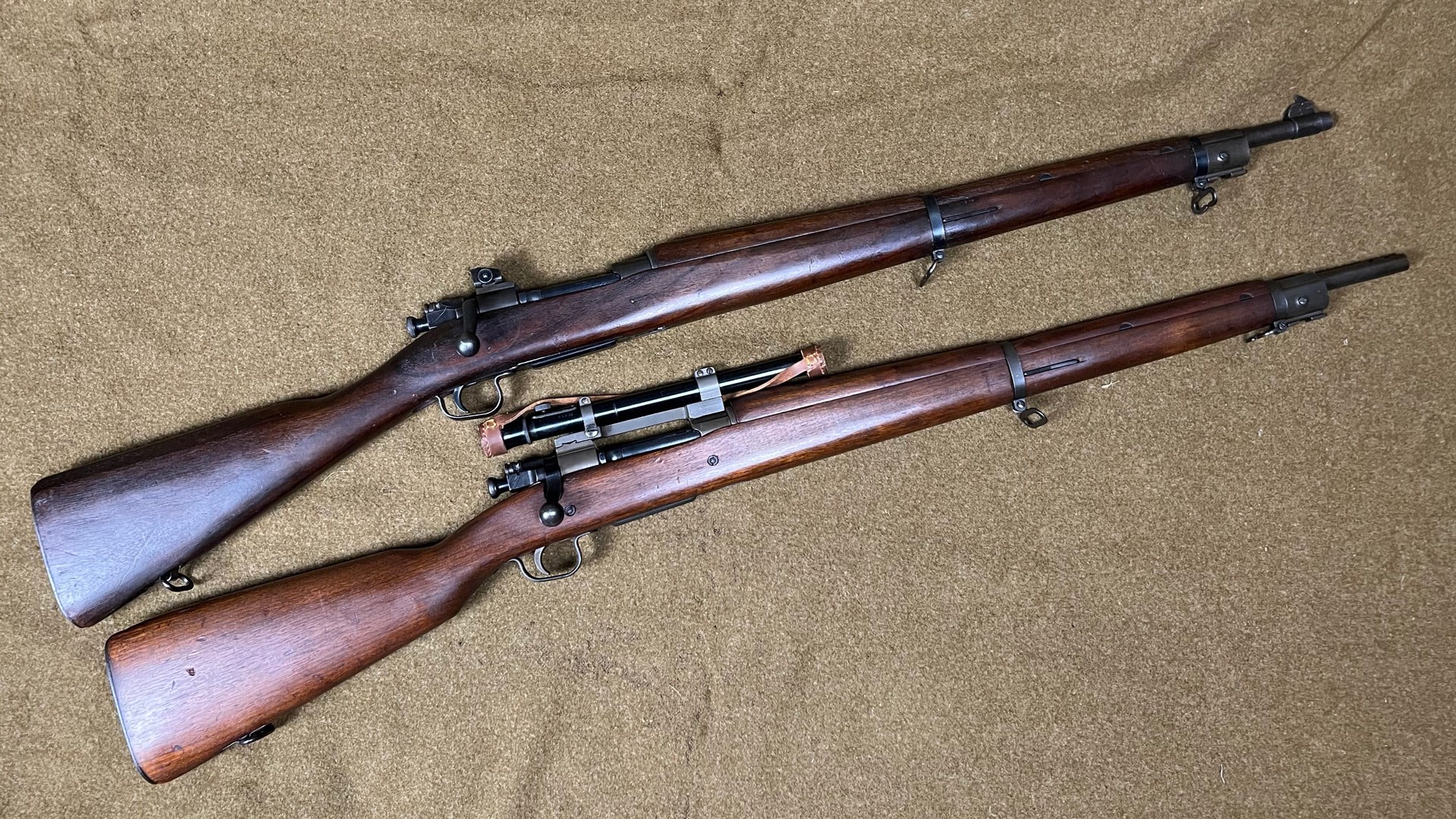 The final standard installments of the M1903 lineage were the wartime M1903A3 (top) and M1903A4 (bottom). While M1903 platforms at heart, they featured significant economy measures to save material, labor and cost.
The final standard installments of the M1903 lineage were the wartime M1903A3 (top) and M1903A4 (bottom). While M1903 platforms at heart, they featured significant economy measures to save material, labor and cost.
Straight stocks with grasping grooves in the fore-end were the standard design for the majority of the M1903’s service life. They were fitted onto the great majority of new-production M1903s from Springfield and Rock Island, as well as early Remington M1903s. The majority will have two reinforcement screws running crosswise through the stock to prevent splitting and damage caused by recoil. Original pre-World War I stocks will have either no bolt or only one on the rear part of the action. These stocks are fairly uncommon, as most were either worn out during their service life or retrofitted to the new two-bolt standard adopted in 1917. Other variations exist in the shape of the comb’s “nose,” the comb itself and height of the wood in relation to the receiver, which is commonly referred to as high wood and low wood. Another variation is a standard-looking straight stock, with grasping grooves, that was additionally inletted for cartridge ejection of M1903 Mark I rifles fitted with a Pedersen Device.
Straight stocks without grasping grooves were used primarily on Remington M1903 rifles, as well as M1903A3s from both manufacturers. While most continued to use stock bolts, for a brief time, simpler and cheaper pins were used on some M1903A3s, but these were generally found to be unsatisfactory for hard use. To quickly tell an M1903 stock apart from an M1903A3 model is the presence of an inlet for the upper handguard ring found on stocks intended for the latter. While an M1903 barreled action will drop into an M1903A3 stock, a M1903’s stock would have to be modified to fit the barreled action of the M1903A3. Most collectors would be aghast at this thought, since A3 stocks are plentiful.
Many would argue that the C-types are the most handsome of all M1903 stocks, and their association with competition rifles probably only increases that allure. The C stocks are found on existing in-service rifles denoted as M1903A1, and it was standardized in early 1928. A majority replacement of straight stocks never came to pass, however, likely because of a mix of demand for the stocks on competition rifles and the eventual testing and adoption of the M1 Garand. C stocks were produced during World War II as well, although they feature a somewhat different profile and were cut for A3 handguard rings. These stocks were used as stocks for Remington M1903A4 sniper rifles, as well as replacement stocks.
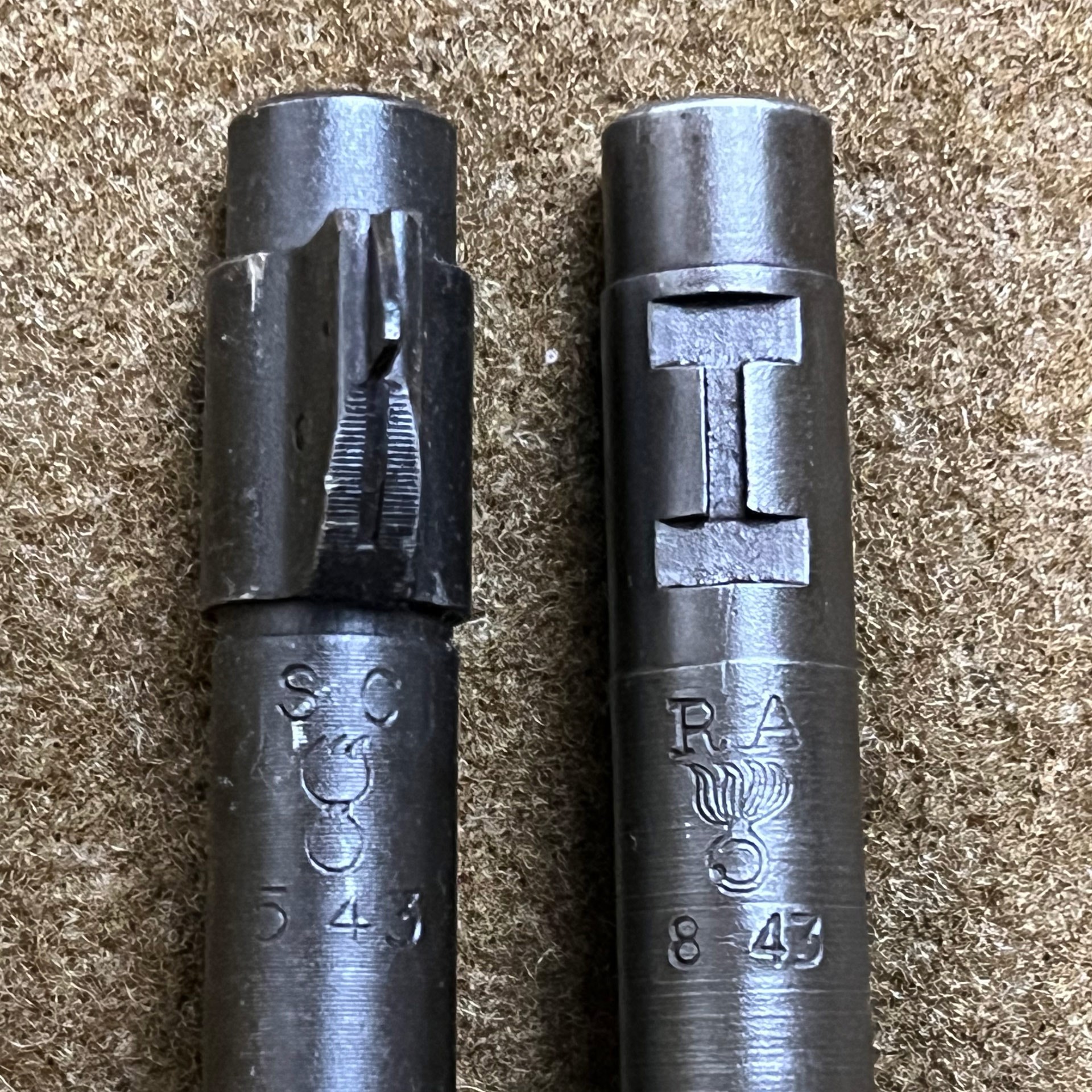 M1903A3s were produced by both Remington and Smith-Corona, while Remington also produced the M1903A4 sniper rifles. As no rear sight was mounted on the A4s, front sights were also left off.
M1903A3s were produced by both Remington and Smith-Corona, while Remington also produced the M1903A4 sniper rifles. As no rear sight was mounted on the A4s, front sights were also left off.
The so-called “scant” stocks are an interesting byproduct of frugality. While the C-type stock had become the official stock to be used on M1903s, the U.S. government realized it had a large amount of stock blanks left that were not large enough to be properly cut into stocks with a full-pistol grip. Instead of turning these into kindling, the decision was made to produce semi-pistol grip stocks. These were primarily used as replacement stocks on M1903 and M1903A3 rifles, although a number of Remington M1903A4 sniper rifles were fitted with scant stocks from the factory.
Understanding M1903 Handguards
Similar to the stocks, handguards for the standard post-rod-bayonet M1903 can be broken into two broad categories with a somewhat bewildering array of sub-types. The “high-hump” sight protector types were in use from 1906-1919, and the straighter-profiled handguards were manufactured from 1920 until the end of spare-parts production.
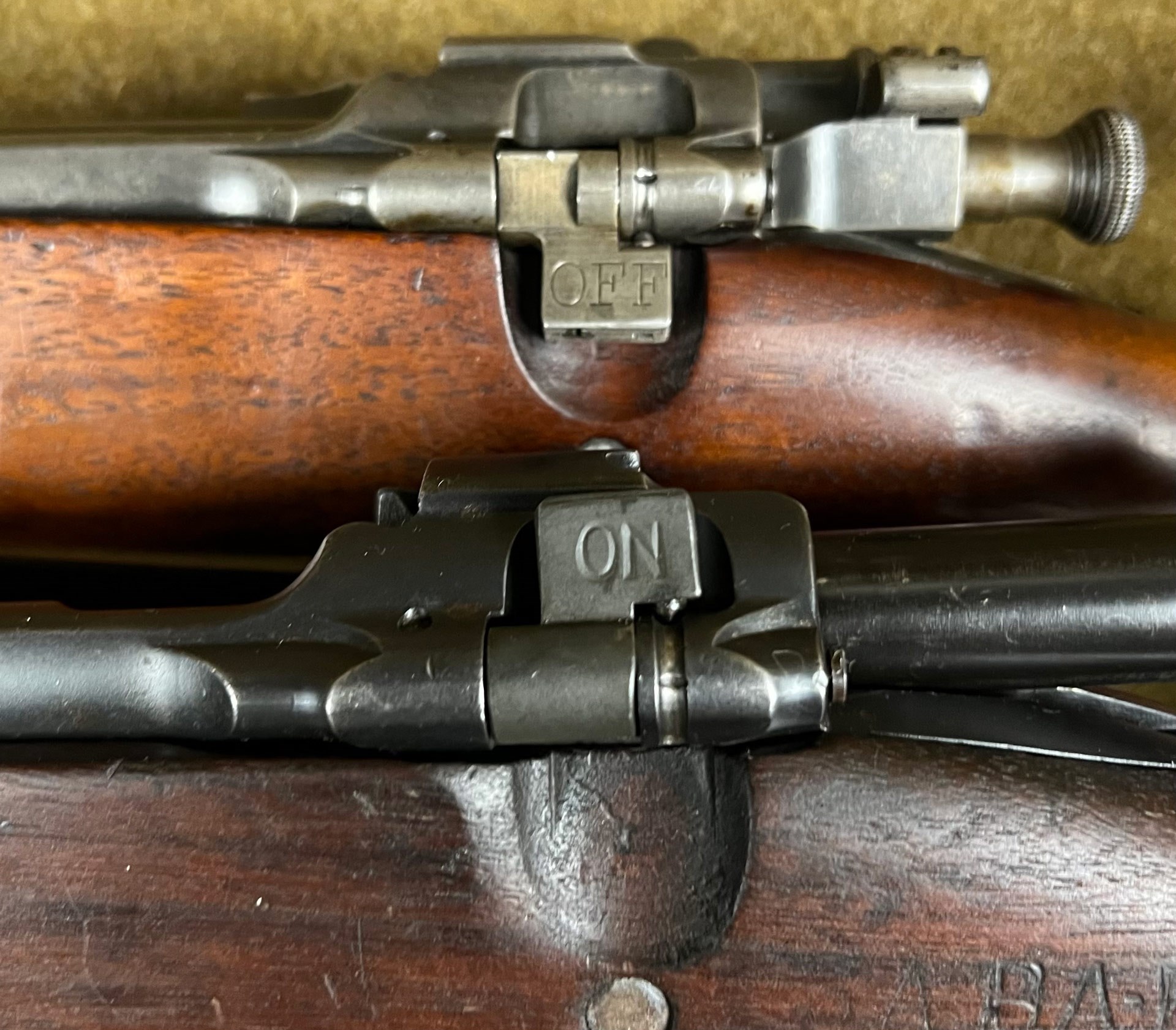 Two magazine cutoffs, one in the down or “off” position, while the other is “on” to allow cartridges to be fed from the magazine.
Two magazine cutoffs, one in the down or “off” position, while the other is “on” to allow cartridges to be fed from the magazine.
The earliest high-hump handguards, roughly 1906-1910, are fairly uncommon and did not feature a sighting groove milled into the top. The primary handguard in use by doughboys during World War I would be one with a pronounced curve, starting low toward the muzzle and rising dramatically higher as it nears the rear sight, featuring a sighting groove milled on top. After World War I, the handguards assumed a straight or slightly concave profile. The M1903A3, as it lacks a barrel-mounted rear sight, requires an entirely different handguard. This handguard runs from the rear of the forward barrel band, all the way to the front of the receiver, and it has a flatter and skinnier profile, as it is not required to protect the rifle’s sight.
M1903 Metal Finishes
All pre-World War I M1903s, and the large majority of those from World War I production, were originally blued with a smooth, polished finish. Parkerizing was introduced in 1918 at both arsenals in order to speed up the manufacturing process and provide a finish more resistant to wear and rust. Post-World War I rifles that were overhauled received a Parkerized finish, as would new-production rifles from Remington and Smith-Corona. Arsenal Parkerization can run the gamut from light gray to gray-green to almost black in color. Interestingly, during the M1903A3’s production, while receivers and barrels were Parkerized, the remaining majority of parts featured a blued finish instead.
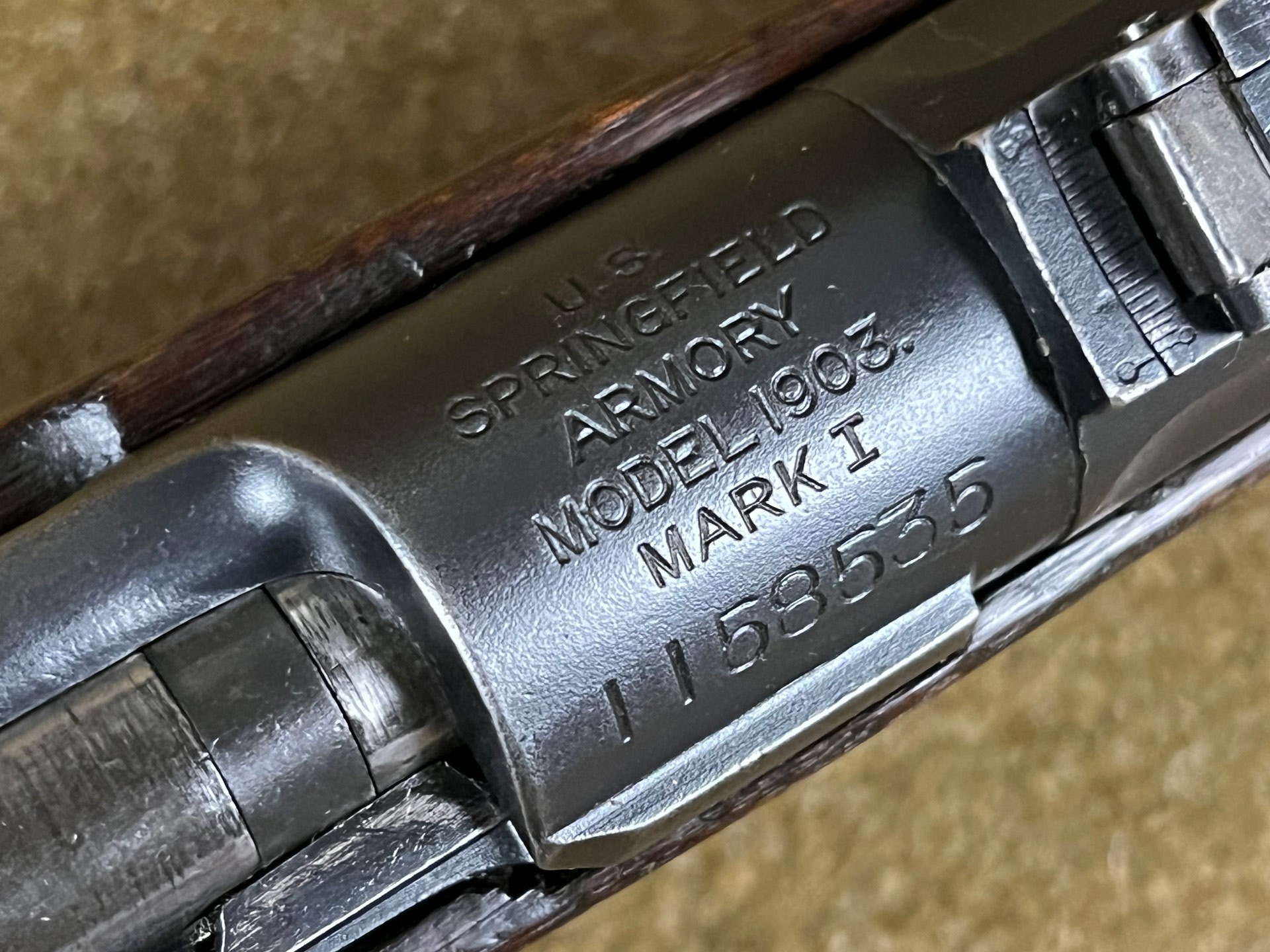 The receiver of the M1903 Mark I is unmistakable, since they were all manufactured after the change to double heat-treatment. All are considered “high numbers.”
The receiver of the M1903 Mark I is unmistakable, since they were all manufactured after the change to double heat-treatment. All are considered “high numbers.”
Miscellaneous Notes
All Springfield and Rock Island M1903s produced prior to 1935 feature a small 0.125” gas-vent hole on the right side of the receiver. These were drilled at the factory and intended, in the event of a ruptured case or other emergency, to divert gases from the fired cartridge away from the shooter. Starting in 1935, a larger hole was added to the left side of the receiver. Colloquially known as the “Hatcher Hole” by collectors, after the famous U.S. Ordnance expert Maj. Gen. Julian Hatcher, this was thought to be a more useful safety feature. Accordingly, many M1903s overhauled after 1935/1936 had this new gas-relief hole added to the left side of the receiver.
Those looking for an M1903 rifle will also eventually come across rifles with an oblong cutout on the left side of the receiver. These rifles will also be invariably made by Springfield Armory, and are stamped “MODEL 1903 [over] MARK I.” Rifles marked in such a way were designed to fit the U.S. Automatic Pistol, Caliber .30, Model of 1918, better known as the Pedersen Device, and the oblong cut serves as the ejection port for the spent pistol-length casings. The Pederson Device would have turned the five-shot, bolt-action M1903 into a platform capable of semi-automatic fire from a 40-round magazine. As-produced Mark I rifles have a number of unique parts that allow for the use of the Pedersen Device, including the cutoff switch, cutoff spindle and trigger/sear. Additionally, the stock contains a slight inlet under the ejection port to aid operation. The great majority of Mark I rifles were overhauled and no longer contain their specialized parts, but they are still an interesting reminder of a secret arm that America intended to deploy during the Great War.
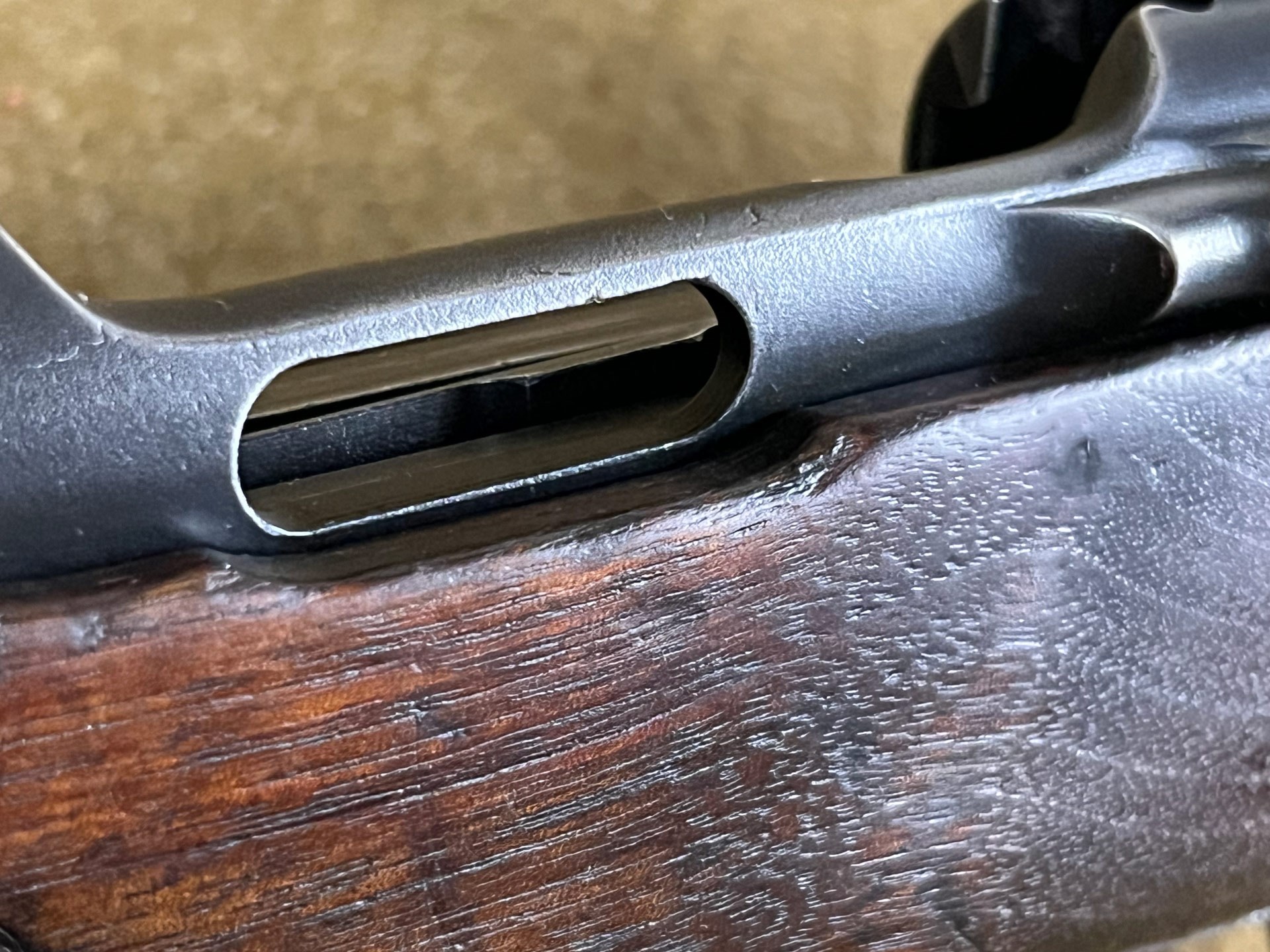 The ejection port for the pistol-size cartridges of the Pedersen Device is also an easy way to identify a rifle as an M1903 Mark I. The shallow inletting immediately beneath the ejection port indicates this is an original Mark I stock.
The ejection port for the pistol-size cartridges of the Pedersen Device is also an easy way to identify a rifle as an M1903 Mark I. The shallow inletting immediately beneath the ejection port indicates this is an original Mark I stock.
The M1903 rifle makes a fine addition to anyone’s collection and is a critical part of that collection for anyone interested in U.S. military small arms. The long service life, parts variations and many markings also make it a fine candidate for the collector wishing to deep-dive on one particular gun. With a little research, they are equally suited for the rifle range, personal collection or living-history display.
Article by JONATHON KRISKO
Don't forget to like us on Facebook and follow us on Twitter.














